We’ve been here for months working on our future house, and it’s finally time to talk about construction, y’all! That’s mostly because we finally have photos of something other than an empty lot to share. We lived in Florida for years but never this close to the coast, so coastal construction has been an education for us. The three South Florida counties (Miami-Dade, Broward, and Palm Beach) adopted stringent building codes after Hurricane Andrew blew through in 1992, and as residents of several of those counties we were certainly aware of the heightened measures required by the codes. We were also intimately and painfully aware of the dramatic differences in insurance rates paid on homes built under the old vs. new building codes. We assume those insurance pencil-pushers know a thing or two about expected losses, and always felt comfortable living in homes built under the latest and greatest codes.
It took a few decades after 1992, but eventually the rest of our great state realized that hurricane risk is not limited to South Florida, and the stringent hurricane building codes now apply statewide in all coastal areas. Our construction project on the slim barrier island of St. George Island puts us directly within one of those coastal zones where homes must be designed to withstand very high winds (140 mph in our case). Add in the fact of being in a flood zone (again, barrier island) and our project brought us into an entirely new territory of design requirements.
To make things even more interesting, we had also never designed a house completely from scratch before. We hired an architect who focuses exclusively on coastal residential construction, but even with his wealth of experience we needed to take the lead on making key design decisions. We quickly discovered that starting with a blank slate gives us way too much opportunity to be creative. For us, the process was basically a version of the events of If You Give a Mouse a Cookie. It was the very definition of slippery slope.
A small example: We love cooking on propane in our Airstream, and we had gas service at the last sticks-and-bricks house we owned. There are no gas lines on SGI, but there are local propane companies that will fill home tanks. So of course we penciled in the idea of an exterior propane tank. And once you are planning to sign up for regular propane deliveries, the next obvious question is what other appliances might be suited for gas. How about a tankless water heater? What about the clothes dryer? Literally every decision can turn into an endless rabbit hole like this.
Our land was raw land, which also gave us a blank canvas to work with. We considered many different options for siting the house (and future pool!). Setback requirements and our desire to save as many trees as possible provided some constraints, but even so we considered many different options for how to locate and orient the house and driveway. Just figuring out the stairs was a project.
Why are stairs a big deal? Well, our flood zone is AE13, meaning that we are required to have our lowest finished floor at least 13 feet above sea level. Our lot is 8 feet above sea level, so in theory we could put the house on 5 foot pilings and meet code. But once you are planning to lift the entire house onto pilings, you might as well make it high enough to use the area below the house as a carport. And once you’re going to park a big truck under there, you might as well have room for an Airstream. And if the Airstream is going to be parked for the winter, you probably want to be able to get up on the roof and do repairs/upgrades while it’s in the shade under the house. And who knows what other recreational toys might be in our future? The cookie thing strikes again. The end result of this process is that our plans call for 14 feet of clearance between our future slab and the bottom of the concrete girders supporting the house.
So we need a way to get ourselves from ground level to our doors that will be 14 feet in the air. That’s a lot of stairs. Moreover, the building code only requires one set of stairs, but I have seen enough documentaries about the Triangle Shirtwaist Factory to know that we need two. So that meant figuring out what locations made the most sense for these large banks of stairs to start on the ground floor, and enter the house at the second floor. We have seen plenty of local examples of stairways that are oddly placed or detract from the appearance of the home, so we took a lot of care in resolving this three-dimensional design problem. And of course once you’re doing several sets of stairs it’s a good time to think about placing utility rooms underneath the staircases, right?
We worked on the plans very deliberately to make sure we were comfortable with the important design decisions. It felt like a major victory when we completed our plans, but of course that is just the beginning of the construction process. Once the plans were final it took several weeks to get health department approval of our proposed septic location and then eventually our building permit, which then started the clock on our biggest timing challenge: pilings.
The pre-stressed concrete pilings and girders are a long lead time item in coastal construction because they are custom fabricated based on the house design. And they are expensive, so it makes no sense to order them until the building permit is in hand. In our case, the fifteen pilings are each 30 feet long with just over half that length (16 feet) driven into the sand. The girders span the pilings like the Greek letter pi (Π) and are bolted into the pilings. Those girders have huge bolts embedded in the concrete that point upward, where our eventual floor trusses will be bolted down. All those connection points are part of hurricane readiness.
Hurricane winds are so powerful they can lift thousands of pounds of roof off a house like a hat flying off a person’s head on a windy day. A hip roof with no eaves provides some benefit by offering no lip for the wind to grab, as the colonizers of Caribbean islands discovered centuries ago. In modern construction the philosophy is to bolt down each element of the house to the one below, instead of merely relying on gravity to hold them down.
One of the reasons we selected our builder is that he knows about wind, as he advertises on his signs. One of his points of pride is that he completed construction on a home in St. Maarten just weeks before the island was devastated by Hurricane Irma in 2018, and the home came through the storm completely unscathed. We’d like to have the same level of security, but also large windows and good views. So basically we are looking for a bulletproof bunker that is also open, airy, and full of light. We’ll see how this works out.
At least we are underway with the project. It was quite exciting having giant equipment working on our lot, especially since we just dropped by and didn’t spend hours listening to the machinery at work. Happily we already made nice with the neighbors who had to put up with several days of the ear-splitting sound of pile-driving. Now that our pilings and girders are in place, the rest of the construction schedule can start to be filled in based on availability of various contractors. It will be a long slog but it feels good to see tangible signs of progress.
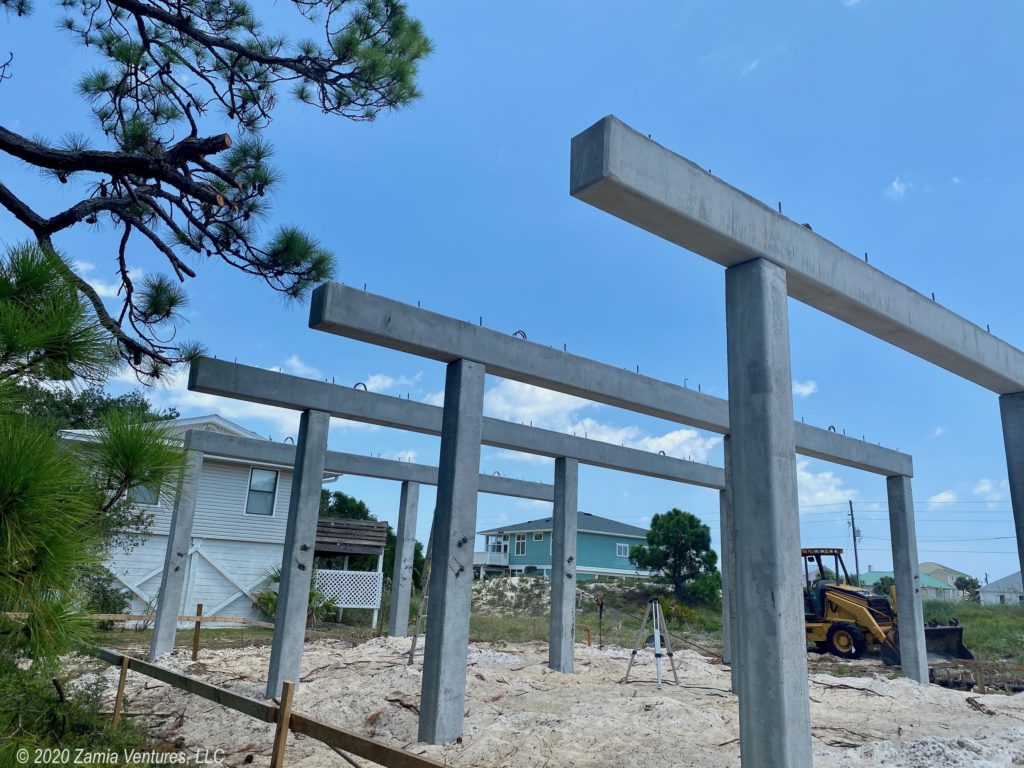
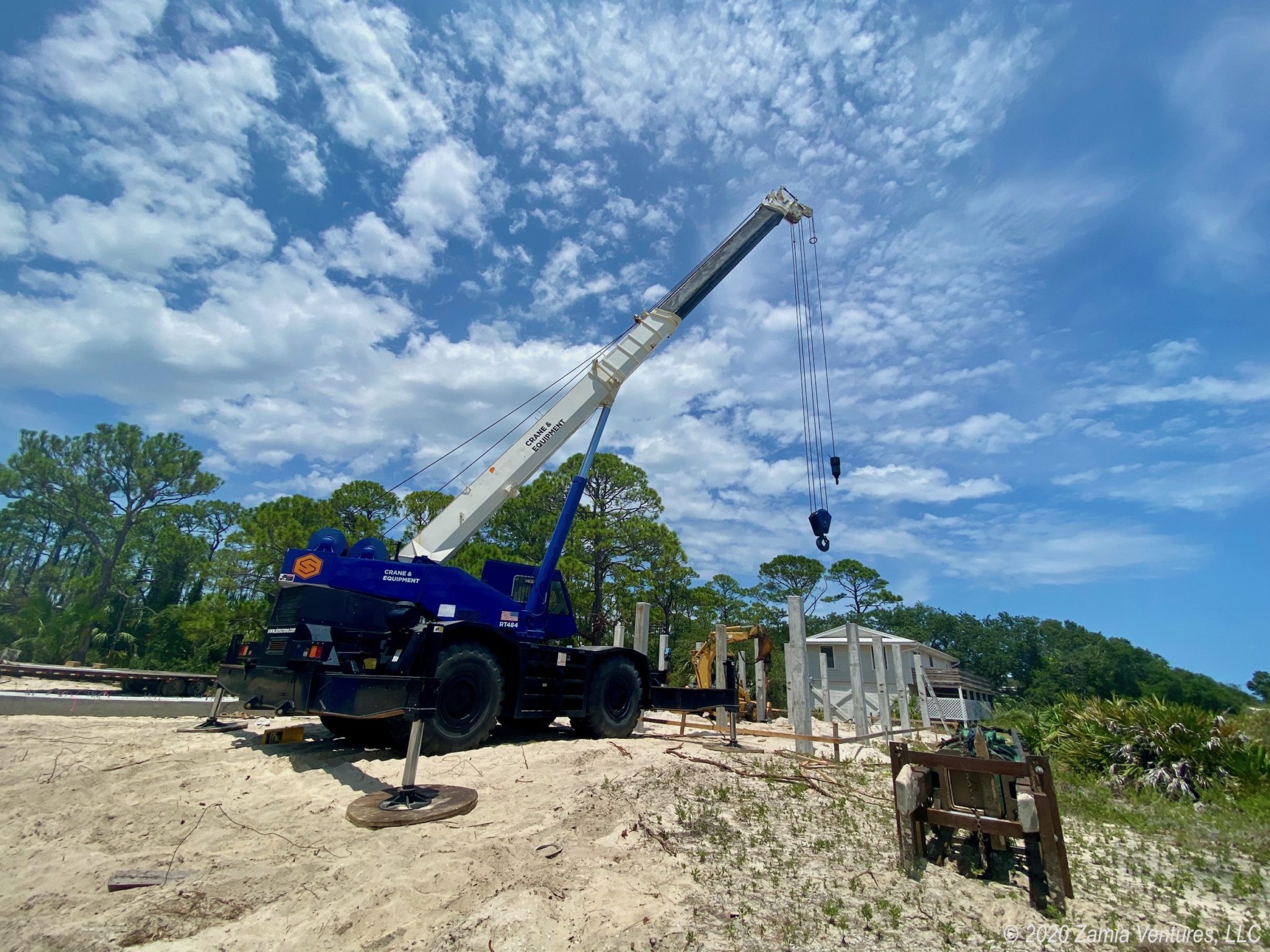
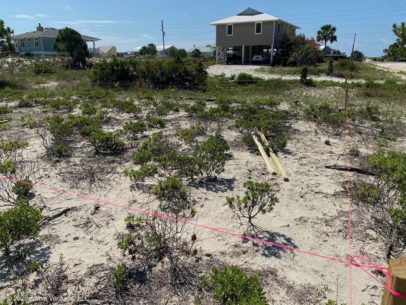
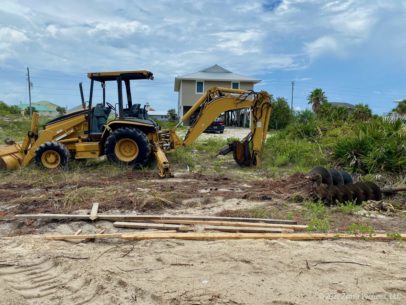
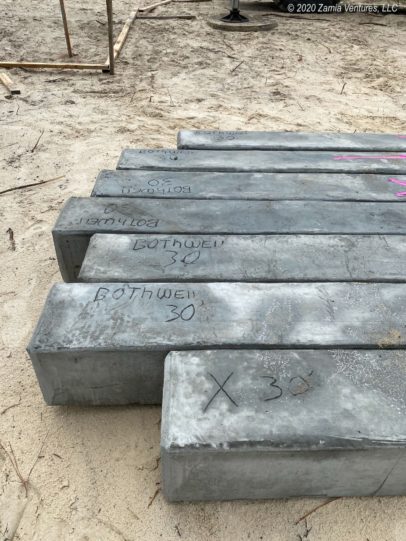
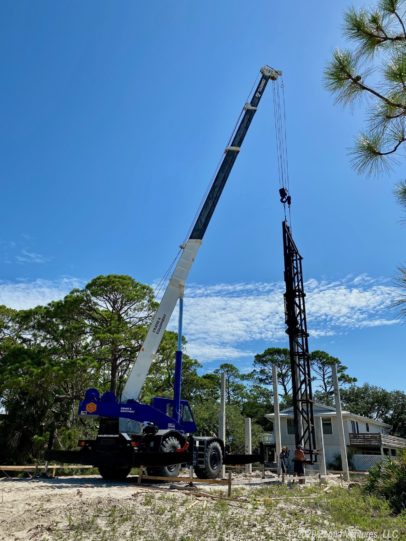
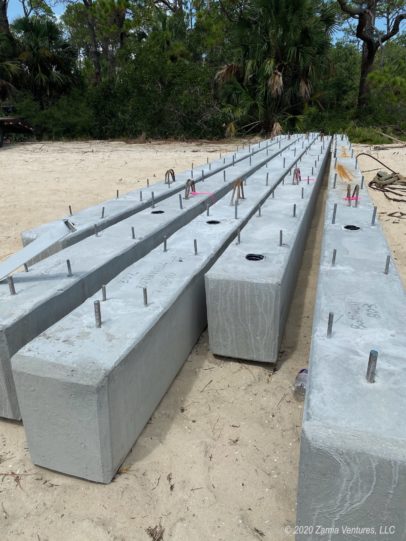
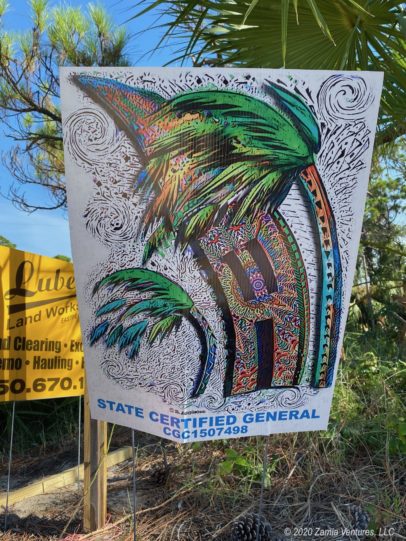
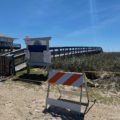

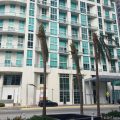
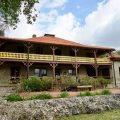
Holy buckets, that’s going to be quite the stilt-house! I hope it never has to endure a hurricane, but if it does, it’ll at least have the best chance possible to come through it unharmed. The stuff in the carport, not so much 😀
You must be so excited to see all those hard-thought plans begin to materialize!
Welcome to coastal living! The vast majority of the homes on the island are on stilts, though there are a few places on grade that were built before modern building codes. I am sure they have been inundated by storms over the years. Our neighbor tells us that our lot basically remained dry during Hurricane Michael (he had several feet of water underneath his house) so we are hopeful that we could get through a storm in good shape. Our general plan is to not be in Florida during hurricane season, so the Airstream and truck would be on the road, and the goal is to have a house to return to in the fall. All this discussion about storms reminds me that while we are very excited to be building something new, we also recognize that it’s a vulnerable asset. Luckily minimalist living in an RV has helped us limit our attachment to material things.
Love the contractor’s poster. We applaud your efforts, location, and courage. As a fifth generation Floridian, we would expect nothing less of you. This bunker is going to be awesome, when can we move in?? Can’t wait to see it come to fruition—we are looking forward to it anxiously, as well. Your adventurous spirit is enviable and we enjoy following your posts. Love you guys, Bill and Linda
Our builder is very good at building solid structures but also has a strong artistic flair, which was a perfect combination for us. We are pretty excited about the future house, even though we still have a very long way to go. Can’t wait to show it off to you guys when it is done! Also, funny that I ended up living close to where our ancestors lived in the early 19th century. It’s truly a small world.
This is awesome. I’m glad you’re sharing the process, so we get to learn right along with you. And I can totally see the “mission creep” that is inherent to a project like this. “If we’re gonna do this, why not that…?” Yup…. just add a couple zeroes to the bottom line. But, it will be so much fun and when it’s done, it will be exactly what YOU want.
Also, I have to say, adding the extra height to accommodate the Airstream not only makes sense from a utility point of view, but you may as well get as much ground clearance as possible. The last thing you want if a hurricane does come through is to wish you had built “just one foot higher…” Simply put, better safe than sorry.
Our favorite part about the process is definitely the customizations we are making that suit us perfectly. We looked at a bunch of existing homes on the island before deciding to build, and ultimately determined it would be too expensive or impossible to make them into exactly what we wanted. Building became an “easy” choice even though we knew it was going to be a long process with many decisions to be made.
We are very comfortable with the decision to build higher. Besides the obvious benefit of a free cardio workout every time we leave or enter the house, the elevation gives us good flood protection and possibly better sea breezes. And since we do believe in the reality of sea level rise it was certainly better to add a few feet for safety.
Although we’ve had the good fortune to chat in person about your new home, and we’ve actually seen the pilings, it’s fun and interesting to read about your thought process and decisions. Having experienced several remodels, I can only imagine how many more decisions have to be made when you’re building a home from scratch. Especially a home that has to be hurricane-proof!
You found the perfect builder to create your airy, light-filled, artistic bulletproof bunker. And we’re certainly grateful that you’ve shared him with us for our little remodeling project! We’re delighted that you’ve chosen St. George Island as your home. We’ll celebrate your progress with socially-distanced beer and oyster happy hours!
We can bore you with even more details when we see you in person, if you’re interested. The whole construction process is sort of fascinating in its own way, though maddeningly slow in many respects. Thanks to the pandemic we have all kinds of time.
We are really happy with our builder, with the community, and with the island. You guys are a big part of that, of course! I just wish we could enjoy more of what the area has to offer right now. But we shall console ourselves with oysters and beer….
I am so amazed and fascinated by your challenge to build a house in an island. EVen the challenge to build an addition on our house required a lot of planning. I,m sure when this house is finished, you will call it your pride and joy. When we were living in Illinois, we bought a lot on a made made lake with our own blueprints to build on that lot which slanted down to the late. Again, this was the second house we never got to build because of moving with Frank,s job. I am anxious to see the finished project. Love, Aunt Jay
We are certainly excited about the project, though it is a little daunting. The fact that we have to make decisions on everything from the layout to the size of every window means there are so many variables to consider. It’s definitely a good thing that we are here in person, since meeting with our contractor and seeing the site in person are both very helpful.